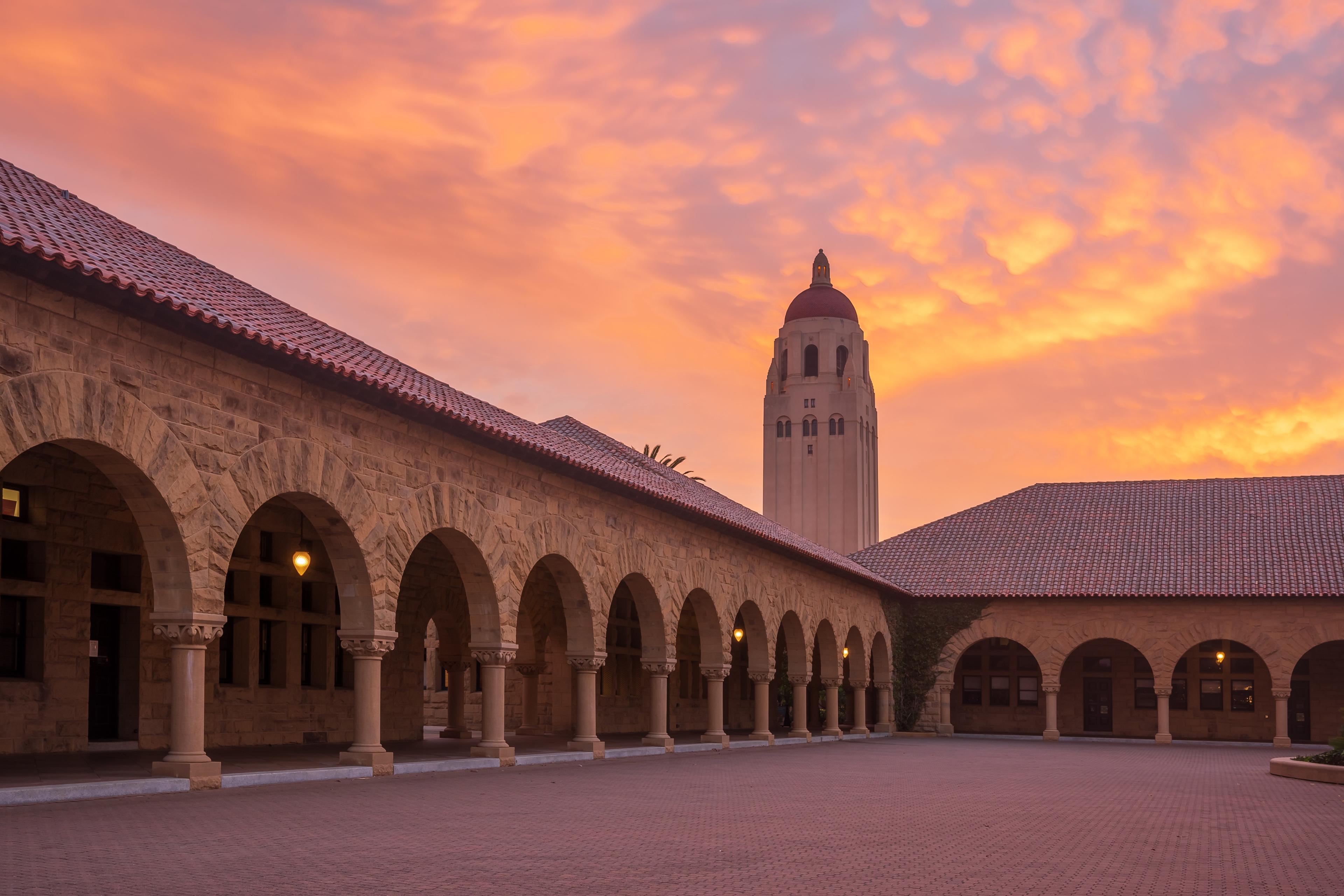Stanford University School of Medicine: Admission Requirements and Application Process
If you're considering applying to Stanford University School of Medicine, it's important to know the admission requirements and application process. Learn how to craft a successful application with our comprehensive guide.
Posted June 27, 2025

Join a free event
Learn from top coaches and industry experts in live, interactive sessions you can join for free.
Table of Contents
Founded in 1858, Stanford University School of Medicine is one of the most prestigious medical schools in the world. Medical students at Stanford’s School of Medicine benefit from small class sizes, personalized mentorship, and hands-on clinical experience. Stanford University School of Medicine is also home to several research centers and institutes, bringing together doctors and scholars from various fields to collaborate on groundbreaking research projects aimed at improving human health. The school also has a strong commitment to diversity and inclusion, with programs and initiatives aimed at promoting equity and access for underrepresented groups. In this article, we’ll give a comprehensive overview of the application process. admission requirements, and MD program, along with tips and strategies for a successful application.
Stanford Medicine MD Admissions Statistics (Class of 2024)
- Total Applicants: 8,998
- Interviews Offered: 497
- Class Size: 90
- Acceptance Rate: ~1%
- Median GPA: 3.94 (10th–90th percentile: 3.68–4.00)
- Median MCAT Score: 518 (10th–90th percentile: 511–525)
- Students Receiving Financial Aid: 76.8%
- Average Medical School Debt for Graduates: $156,377
Stanford School of Medicine remains one of the most selective medical schools in the United States, with a holistic admissions process that emphasizes more than just academic metrics. The admissions committee carefully considers personal character, leadership experience, intellectual curiosity, commitment to service, and potential for meaningful contributions to the field of medicine.
Stanford Medicine MD Application Requirements
Like most medical schools, Stanford University uses the American Medical College Application Service (AMCAS) to receive its medical school applications. One important aspect of the Stanford medical school application is the emphasis on a well-rounded applicant. While academic achievements and test scores are important, the admissions committee also looks for applicants who have demonstrated leadership, community service, and passion for medical science. It’s important to showcase these qualities in your personal statement, letters of evaluation, and extracurriculars. Here’s what Stanford looks for:
- Academic Achievement: Competitive GPA and MCAT scores are essential, but not sufficient on their own.
- Holistic Qualities: Personal integrity, resilience, collaboration, and a passion for innovation in medicine are highly valued.
- Leadership and Service: Demonstrated commitment to improving health outcomes through advocacy, volunteerism, or professional work.
- Research Engagement: Students are encouraged to pursue scholarly concentrations and many participate in programs like the Medical Scientist Training Program (MSTP), Physician-Scientist Training Program (PSTP), and Discovery Curriculum tracks.
Application Deadlines (2024–2025 Cycle)
All deadlines are 11:59 PM in the time zone specified. Confirm all dates on the Stanford MD Admissions page for the most current updates.
- May: AMCAS Primary Application opens
- June–October: Stanford receives AMCAS applications and sends out Supplemental Application invitations
- October 1: AMCAS Primary Application deadline (11:59 PM ET)
- October 8: Stanford Supplemental Application and all materials due (11:59 PM PT)
- August–January: Applications reviewed; interview invitations sent
- January–March: Admission offers extended
- April: Discovery Days for accepted applicants
- April 30: Deadline to accept a single MD offer (per AAMC guidelines)
- August: Orientation and first day of class
Expert Tip: Apply as early in the cycle as possible to increase your chances of consideration. Make sure your transcripts, MCAT scores, letters of evaluation, and essays are submitted well before the stated deadlines.
Academic Prerequisites
While Stanford Medicine does not have specific course requirements needed for admission, you will need to take courses in the following subjects:
- Biology
- Chemistry and Physics
- Physics and Mathematics
- Laboratory or Field Experiments
- Behavioral and Social Sciences
- Communication
Applicants must hold a bachelor’s degree from an accredited institution by the time of matriculation.
Note: While there are no strict course requirements, Stanford values applicants with a strong foundation in scientific reasoning, critical thinking, and human behavior skills, often gained through courses in these areas.
AMCAS Application
- Identifying Information: You’ll submit your biographic information here.
- Schools Attended: You’ll need to enter all high schools and postsecondary institutions attended, as well as official college and university transcripts.
- Biographic Information: Here, you’ll enter additional personal information, such as language proficiency, residency, and any challenges you have faced.
- Coursework: Enter all postsecondary courses you took. These will be used to determine your AMCAS GPA.
- Work/Activities: You’ll enter up to 15 experiences here, such as employment, extracurriculars, honors and awards, and publications.
- Letters of Evaluation: Stanford requires between three and six individual letters of evaluation. All letters must be on official letterhead and signed by your recommenders. You may also submit letters from a pre-health committee.d and signed by your recommenders. You may also submit letters from a pre-health committee.
- If you are submitting a committee packet containing four individual letters, the letter requirement is fulfilled, with the option to submit up to two more letters.
- If the committee letter does not contain any individual letters, you’ll still need to submit three to six additional letters.
- Essays: You’ll need to submit a personal comments essay of 5,300 characters or less explaining why you are pursuing medicine. This essay is sent to all medical schools you apply for.
- If you’re applying for the Medical Scientist Training Program, Stanford’s MD/PhD program, you’ll need to submit two additional essays.
- The MD-PhD essay asks you to explain why you are pursuing a MD/PhD in up to 3,000 characters.
- The Significant Research Experience essay gives you 10,000 characters to detail your research experiences. If your work was published, you should include the full citation in the Work/Activities section.
- Standardized Tests: For the 2024–2025 application cycle, Stanford Medicine requires applicants to submit MCAT scores from exams taken no earlier than January 2021 and no later than September 2024. While the MCAT is required, Stanford also allows you to submit additional standardized test scores, such as AAMC PREview, LSAT, GRE, GMAT, and MAT. These supplementary scores are optional and may be considered if they offer meaningful insight into your academic strengths or background.
- Fees: Finally, you’ll need to pay a $175 application fee for the first medical school you apply for and $45 for additional schools.
For more information, see the 2025 AMCAS Applicant Guide.
Stanford MD Supplemental Application
After submitting the AMCAS application, you’ll receive an email inviting you to fill out the Stanford supplemental application. The personal essay prompts are:
- Are there any current or pending disputes concerning your academic status? If yes, please explain. (300 characters)
- Was your enrollment status ever interrupted during your undergraduate or graduate program, not including summer term (e.g. medical, personal, or academic reasons, military service, other)? If yes, please explain. (150 character limit)
- What do you see as the most likely practice scenario for your future medical career? Please describe your motivation for this practice scenario. Why do you feel you are particularly suited for this practice scenario? What knowledge, skills and attitudes have you developed that have prepared you for this career path? (1,000 character limit) Choose the single answer that best describes your career goals and clinical practice setting:
- Academic Medicine (Clinical)
- Academic Medicine (Physician Scientist)
- Non-Academic Clinical Practice
- Health Policy
- Health Administration
- Primary Care
- Public Health/Community Health
- Global Health
- How will you take advantage of the Stanford Medicine Discovery Curriculum and scholarly concentration requirement to achieve your personal career goals? (1,000 character limit)
- Describe in a short paragraph your educational and family background. (600 character limit)
- Please describe which aspects of your life experiences, interests, and character would help you to make a distinctive contribution to Stanford Medicine. (2,000 character limit)
- Please describe how you have uniquely contributed to a community with which you identify. (1,000 character limit)
- Please describe an experience/ situation when you advocated for someone else. (1,000 character limit)
- Please include anything else that will help us understand better how you may uniquely contribute to Stanford Medicine? (Optional, 1,000 character limit)
- Health Belief and Attitude Survey
- Give your opinion for each item using the responses Strongly Disagree, Moderately Disagree, Mildly Disagree, Mildly Agree, Moderately Agree, and Strongly Agree. Prior to any potential use of this information for any research purpose, your name and unique identifiers will be removed from the data set to ensure anonymity.
- Physicians should ask patients for their opinions about their illness
- It is important to know patients' points of view for the purpose of diagnosis.
- Patients may lose confidence in the physician if the physician asks their opinion about their illness or problem.
- Understanding patients' opinions about their illness helps physicians reach correct diagnosis.
- A physician can give excellent care without knowing patients' opinions about their illnesses or problems.
- Understanding patients' opinions about their illnesses helps physicians provide better care.
- A Physician can give excellent health care without knowing a patients' understanding of his or her illnesses.
- Physicians should ask their patients' what they believe is the cause of their problem/illness.
- A physician should learn about their patients' cultural perspective.
- Physicians can learn from their patients' perspectives on their illnesses or problems.
- Physicians should ask their patients why they think their illness has occurred.
- Physicians should ask about how an illness is impacting a patient's life.
- Physicians should make empathic statements about their patients' illness or problems.
- Physicians should ask patients for their feelings about their illness or problems.
- Physicians do not need to ask about patients' personal lives or relationships to provide good health care.
Stanford MD Admissions Interview
Interview invitations are extended to about 6% of applicants on a rolling basis starting in August. All interviews are virtual and take place between September and February. Decisions are sent out between January and March. Waitlist offers are extended until the class is filled.
Our Tips for the Interview:
- Your interviewer will most likely have reviewed your application in depth, so focus on discussing personal experiences and qualities that are not already listed in your application.
- Consider Stanford’s mission statement of improving “health through leadership, diversity and collaborative discoveries and innovation in health care, education and research.”
- Come with questions: this is also your opportunity to learn more about the educational mission, medical care, environment, and culture of Stanford Medicine, and thoughtful questions can help demonstrate genuine interest in the school.
- Practice, practice, practice! An experienced admissions coach can support you through the application and interview and help you determine which personal qualities will make you stand out.
Stanford MD Curriculum Overview
Pre-Clerkship
All incoming medical students are matched with an Educator-4-Care faculty mentor and clinical teacher who will support them throughout their time at Stanford. The two-year pre-clerkship education focuses on three areas: Foundations, Practice, and Science of Medicine, as well as an Early Clinical Engagement course. In the second year, students may choose to complete the remaining courses over one or two years. Taking an additional year gives students the opportunity to pursue dual degrees or research.
Students must declare one of eight scholarly concentration foundations, or design one independently:
- Bioengineering
- Biomedical Ethics and Medical Humanities
- Clinical Research
- Community Health
- Health Services and Policy Research
- Informatics & Data-Driven Medicine
- Medical Education
- Molecular Basis of Medicine
Students may also choose one of ten application areas for their scholarly concentrations:
- Cancer Biology
- Cardiovascular Pulmonary
- Global Health
- Health Equity and Social Justice
- Immunology
- Neuroscience
- Prevention Research
- Quality Improvement
- Surgery
- Women's Health and Sexual and Gender Minority Health
These scholarly concentrations include a required research project consisting of a written report, oral presentation, and mentor letter of summary. Students will also need to take at least 12 units of courses in the area.
Students will need to complete the Mini-Clerkship Performance Examination (CPX), a five hour exam, to begin clerkships.
Clerkship
Students will complete the following clerkships:
- General medicine
- General surgery
- Critical care
- Emergency medicine
- Family medicine
- Ambulatory medicine
- Neurology
- Obstetrics & gynecology
- Pediatrics
- Psychiatry
- Selective/elective clerkships:
- Fundamentals of clinical care, including:
- Addiction treatment services
- Chronic pain management
- Diagnostic radiology and nuclear medicine
- Dermatology
- Family practice office
- Ophthalmology
- Orthopedics
- Otolaryngology/head and neck surgery
- Trans-disciplinary breast oncology
- Trauma psychiatry
- Subinternship, such as:
- Advanced medicine
- Burn center
- Cardiothoracic surgery
- Community hospital pediatrics
- Pediatric hematology and oncology
- Plastic surgery
- Neurosurgery
- Fundamentals of clinical care, including:
The extensive clerkships provide students with opportunities to participate in patient care in various settings, learn from doctors with professional expertise in different specialties, and gain an understanding of the future residencies they will go into. Students must also take the Advanced Cardiac Life Support course, the Reflection and Contextual Medicine course, and the CPX to graduate.
Cost of Attendance
| Pre-Clerkship Year | Clerkship Year | |
|---|---|---|
| Tuition | $65,343 | $87,124 |
| Estimated On-Campus Living Expenses | $41,371 | $52,892 |
| Estimated Off-Campus Living Expenses | $47,056 | $60,472 |
Although the costs of attending and living in the area are high, Stanford is determined to provide a high-quality education to students regardless of their financial situation. Most students receive financial aid and have about half the debt of the national average. Review Stanford’s financial aid policies here.
Bottom Line
Stanford School of Medicine looks for more than just high test scores and GPAs. Successful applicants bring a clear sense of purpose, a strong track record of service and leadership, and the ability to thrive in a research-driven, collaborative environment. If you’re aiming for Stanford, it’s critical to craft a compelling application that reflects your unique strengths, values, and vision for a career in medicine.
Work With a Medical School Admissions Coach
Want help standing out in Stanford’s ultra-competitive admissions process?
Get one-on-one support from experienced medical school admissions coaches who know what it takes, from personal statements and interview prep to letters of recommendation and strategy.
For more information, check out these articles:
- UCSF Medical School: Admissions, Programs, and Tuition Costs
- Med School Application Timeline: Key Dates and Strategies
- A Guide to the T20 Medical Schools in the U.S.
- The Ultimate Guide to the Medical School Application Process
FAQs
What dual degrees can I pursue?
- Popular dual degrees include the MD/PhD, MD/MPH, and MD/MS. Review the full list of dual degrees here.
What GPA do I need to get into Stanford Medical School?
- While there is no official cutoff, successful applicants typically have a GPA near or above 3.9. For the most recent class, the median GPA was 3.94, with most students falling in the 3.68–4.00 range.
Is Stanford or Harvard Medical School better?
- Both Stanford and Harvard are considered among the top medical schools in the world. Harvard often ranks slightly higher overall, but Stanford is renowned for its research opportunities, innovative curriculum, and personalized mentorship. The better school depends on your academic interests and career goals.
What MCAT score is needed for Stanford?
- Competitive applicants usually submit MCAT scores above 515. The median MCAT score for Stanford’s most recent class was 518, with a range of 511–525. Applicants should aim for scores in the 90th percentile or higher.
Is Stanford Medical School difficult to get into?
- Yes, Stanford is extremely selective and uses a holistic review process. In addition to high GPA and MCAT scores, applicants need strong personal essays, leadership experience, community involvement, and a clear commitment to medicine to be seriously considered.
Browse hundreds of expert coaches
Leland coaches have helped thousands of people achieve their goals. A dedicated mentor can make all the difference.













